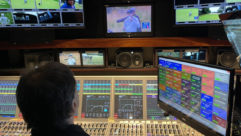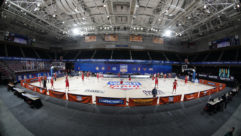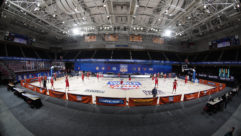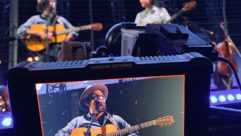The Roar of the Crowd
Nov 1, 1997 12:00 PM,
Toni Flosi
Despite unprecedented deadlines, daunting technical requirements and thepassing of an NFL legend, the sound system for the Washington Redskins’ newstadium is no copy cat.
To reach the areas on the side of the stadium that did not have line sightto the clusters, a distributed system of some 130 Community full range,three-way loudspeakers was placed across 130 yards of grandstands.
There are few places in all of America whose sports fans are as devoted asthose of the Washington Redskins football team. Although Chicago has itsBulls boosters and Boston its legion of Red Sox faithful, the Redskins fansare truly in a class by themselves when it comes to loyalty in the NationalFootball League. In fact, every home game since 1969 has been sold out, notto mention the fact that 49,000 fans are on the waiting list for seasontickets. And if three Super Bowl Championships in the last 14 years weren’tenough to keep Beltway fans coming back, the team’s pristine new stadium inLandover, Maryland surely will.
The Redskins’ new stadium is a 78,600-seat labor of love by the team’slegendary owner, Jack Kent Cooke, who recently passed away at age 85. Thenew Jack Kent Cooke Stadium may not have the memories of the team’s formerdigs, the venerable Robert F. Kennedy Memorial Stadium, but what it lacksin history, it makes up for in state-of-the-art facilities. Boasting 284executive suites, 15,000 club or luxury seats, a full 23,000 parkingspaces, and even its own holding cells for the occasional hooligan, the newstadium faithfully carries through on its namesake’s vision, sparing noexpense when it comes to accommodating the Redskins faithful. This isespecially true when it comes to the field’s unique sound reinforcementsystem. Here’s a closer look at what goes into a cutting edge audio systemat one of today’s finest sports facilities.
Field goalsDesigning and installing the audio system at Jack Kent Cooke Stadium posedthree primary obstacles for the team of SR professionals hand-picked byCooke’s construction management group. First of all, the system had to berugged enough to withstand the brutal weather conditions of the Washington,D.C. area, an area prone to high humidity in the summer months and frigidblizzards throughout the fall and winter months.
Moreover, the system had to fit seamlessly into the stadium’sinfrastructure, designed by noted stadium architects, HOK/Sports. Theblueprints, which were personally approved by Mr. Cooke, were carefullydesigned to give every fan an uncluttered view of the action on the field.This was a welcome change from the often poor visibility at RFK, which wasalso the smallest venue in the National Football League.
Finally, the system had to be specified, constructed and installed within atime-frame of just nine months – a fast-track construction scheduledesigned to wrap in advance of the Stadium’s September debut. Needless tosay, the system had to meet all of this criteria and still performflawlessly for both voice and music reproduction – a fairly dauntingassignment for any sound design team.
Game timeThe sound system design assignment was given to the acclaimed sound designfirm WJHW of Dallas with system designer Brad Ricks spearheading theproject. Installation was handled by Signal Perfection Limited (SPL) ofColumbia, Maryland. In consultation with both HOK/Sports and the Redskinsmanagement team, WJHW immediately set out to recreate the audio magic thatthey had brought to such venues as Cleveland’s Jacobs Field, the Toronto(Raptors) Skydome, and the new home of the Jacksonville Jaguars. Projectleader Fred Curdts of SPL and his installation team became involved at theonset, coordinating such issues as conduit, wiring and cabling in additionto loudspeaker mounting and equipment setup. Often working alongside aconstruction crew of 1,000 laborers, foremen and specialists who werepouring concrete as the audio equipment was hoisted into position, therewas no margin for error.
After assessing the stadium’s infrastructure, seating configurations,environmental noise concerns and weather, the design team decided againstend zone loudspeaker placement and began to map out another, more plausibleconfiguration.
“We basically wanted to place the loudspeakers where they would have theleast environmental impact while delivering clear, intelligible sound.”Ricks said. “A complete distributed system was deemed cost-prohibitive. So,we decided to mount a central cluster on the 50-yard line with an auxiliarycluster at each goal line to cut the harsh angles and long-throw distances.This put three clusters on the same side of the stadium. To reach the areason the side of the stadium that did not have line sight to the clusters, adistributed system of some 130 Community full-range, three-way loudspeakerswas placed across 130 yards of grandstands. In essence, the audio action atJack Kent Cooke Stadium is a truly one-sided affair.
“As I got into this project, I recognized that Community’s manifolded M4sand EM282 drivers had the ability to deliver the high power levels that Iwas looking for in the mid and upper frequencies. The M4 is one of the besthigh-powered drivers available. So, I specified speakers that utilized theM4 and EM carbon-fiber diaphragms to achieve required levels.”
Acoustical weaponryRicks decided on a configuration consisting of the new Community CBA/CBSSystems in addition to a full Community distributed system. (The CBA/CBSsystem is the contractor version of Community’s new AirForce ConcertSystem.) The CBA/CBS is a three-way, high-output, high-power, horn-loadedsystem that uses the latest driver technologies for superb clarity andtransient accuracy in large stadium environments. Prototypes of these unitsare used in Raptors Stadium.
The system is based upon the powerful Community M4 driver for seamlesscoverage of the entire midrange from 300 Hz to 1.5 kHz. Response extensionabove the M4 is handled by a Community EM282 driver, which covers the rangefrom 1.5 kHz to 7 kHz. The EM282 is generally acknowledged as the onlyhigh-frequency driver thatproduces the same levels as the powerful M4. Bothdrivers have Community’s proprietary carbon fiber diaphragms to providesuperior internal damping, high stiffness-to-mass ratios and reduction ofmechanical failure.
Frequencies above 7 kHz are reproduced by the Community VHF100 driver,which uses a mylar diaphragm and suspensionless design that operate like apiston to the 18 kHz range with a wavefront that is automatically in phasethroughout its operating range. All three drivers are designed with lowcompression ratios that vastly reduce high output distortion normallycaused by air non-linearity in horn throats due to high compression ratios.The M4 reproduces 300 kHz to 1,500 kHz, the EM282 1,500 Hz to 7,000 Hz, andthe VF100 7,000 kHz to 18,000 kHz.
A view from the 50-yard lineThis is the first outdoor stadium application of the CBA/CBS system. All ofthe components used in the CBA/CBS systems are custom designed by Communityfounder Bruce Howze, and they are manufactured and assembled at Community’sChester, PA, facilities to deliver more power with 6 dB to 10 dB lowerdistortion than other available units.
Sitting atop the press box, the forward-facing top portion of the maincenter cluster comprises four CBA3020NE units; the mid portion consists oftwo additional CBA3020NE units placed to the left and right of theCBA9050NE, all angled downwards. The CBA9050NE covers relatively nearfield. The CBA3020 units are used for long throws, and each is loaded withtwo M4, two EM282 and three VHF100 drivers — truly acoustical weaponry. Awhopping 12 CBA315FE subwoofers handle the low end. The CBS315 subwoofer isa horn-loaded low-frequency enclosure with three 15 inch (381 mm) drivers.
To protect the center cluster from the elements and to keep the sound frompermeating into the surrounding areas, a three-sided housing unit with anoverhanging roof was constructed to hold the main cluster. With this typeprotection, Ricks was able to economize and have the mid- to high-frequencyhorns installed without special weatherproofing or cabinetry. However, theexposed end zone cluster cabinets and all fill loudspeakers are constructedof marine plywood cabinets with hand-laminated fiberglass and multilayeredstainless steel grills.
On either end of the field, near the goal lines, smaller satellite clusterscomplement both the center cluster and the distributed network of fillloudspeakers. Each auxiliary end zone cluster consists of one CBA3020FE,one CBA3040FE and four CBA315FE units.
Audio amongst the fans”Community was aggressive in convincing me that they could design andmanufacture the fill loudspeakers I required,” noted Ricks. “I was familiarwith Community’s components and how they function. In discussing coveragepatterns and maximum SPL levels on a speaker-by-speaker basis, I decidedCommunity had the capability to custom-configure the fill cabinets to meetmy requirements using much of their existing components. I wanted toincorporate Community’s EM drivers into some of the longer throw fill boxesto handle a distributed system in the midst of a center cluster systemeffectively. To make it all work required a substantial number of differentbox configurations.”
Each of the various models of fill loudspeakers were meticulously designedby Community to meet the stringent specs set forth by Ricks. The fillloudspeakers include 41 units of the CDFls, six CDF7s, two CDF9s, 13CDF5Us, 12 SLS920FEs and 40 CDF2s. Each of these loudspeakers benefit fromCommunity’s proprietary carbon-fiber diaphragm technology for pristinevocal and music reproduction in outdoor applications. The larger fillloudspeakers use EM282 exit mid-carbon fiber drivers for added clarity andminimal distortion. Part of the requirement for many of the fill speakerswas to have some vertical control of the bass performance and to providethe clarity and lack of distortion in the vocal range via Community’swell-known three-way design coverage. All speakers are synchronized forsignal alignment relative to the main cluster. Many of these designs areapplicable to future stadium use, and they may eventually migrate into thestandard Community lineup.
The stadium offers the best sightlines in the NFL, so keeping thedistributed system relatively unobtrusive to the thousands of Redskins fanswatching the game was no easy task. Fill units were mounted on lightingstandards, on risers, under the balconies, and on specially designedplatforms across three stadium tiers, including club, upper and lowerlevels. The placement and engineering of these loudspeakers required anunusually tight collaboration between Ricks and Howze — a partnershipcharacterized by an abundance of overtime and a high degree of cooperation,trust and rapid decision-making. After all, with an installation scheduleof just nine months, Ricks’ design decisions and Howze’ engineering andtesting time were severely compacted. Nevertheless, all Community designswere painstakingly tested at the company’s factory prior to shipment.
With the clusters and distributed system on one side of the stadium,additional fills were required for the lower deck. A total of 119 weather-resistant Tannoy CPAs, a 7 V version that used the the Tannoy THP 60internally mounted transformer, were used for this task. The 5.25 inch (13cm), point source, ICT (Inductive Coupling Technology) high-sensitivitytransducer provides wide conical dispersion, excellent speechintelligibility and full-range frequency response. On the side of thestadium that houses the clusters there are two CPA 5 (T-60) in an “x” mountformation per seating section. This formation provides full coverage to theforward and to the rear of the seating area located under the decking. Onthe opposite side of the stadium, one CPA 5 (T-60) per seating sectionsupportsg the main system to ensure that patrons at the rear of the seatingarea can hear the program material. A total of 90 Tannoy CPA 5 (T-60) areinstalled at all the concession areas. There is a combined use of audioonly locations and audio to support the many Sony televisions wall mountedaround major traffic zones in the concession and restroom areas.
Noted Fred Curdts, SPL, “They sound great. The point source CPA 5s reallydo the job, providing super vocal articulation and even, seamless coverageto crucial areas of the install.”
Behind the scenesThe main control room is located adjacent to the press box area directlyunder the main center loudspeaker cluster. Controlling this vast network ofdistributed loudspeakers is a Peavey Media Matrix Computer Control signalprocessing system. The Media Matrix MM940 system handles all processing,equalization, routing, delays and the back of house systems through a DellP133 computer.
A BSS FDS-355 Omnidrive Compact Loudspeaker Management System controls thestadium’s center cluster. Representing a radical advance in DSP processingfor loudspeaker control, the Omnidrive Compact System includes fullyprogrammable crossover, digital delay and EQ. Additional processingequipment includes Rane distribution amps, parametic EQs, 1/3-octaveequalizers and a Crest 24 x 4 console.
A total of 94 Crest Audio amplifiers under NexSys computer control providepower to all of the Community and Tannoy loudspeakers throughout thestadium. Powering the 240 Tannoy loudspeakers are 15 Crest CKV400s, 11CKV800s, three CKV200s and one CKV 1600. Designed specifically for 70 Vdistributed systems, the two-rack-space CKV200 and CKV400 feature powerratings of 200 W per channel and 400 W per channel into 70.7 V,respectively. The three-rackspace CKV800 offers 400 W per channel; thefour-rackspace CKV1600 is rated at 800 W per channel.
For the Community loudspeakers, Ricks specified a variety of models fromthe Crest Professional Series. A total of 27 model 8001s, each with a powerspec of 1,200 W per channel into 4 V stereo, drive the lows on each of theCommunity clusters; 17 Model 7001s, 10 model 3301s and 10 model 4601shandle the mids and highs of the clusters, fills and catwalk speakers. Allof the Crest amplifiers are monitored and controlled by NexSys, Crest’sproprietary computer control system.
Noted Fred Curdtz, “The install itself went wonderfully, and having NexSyson board has been a big part of that. We have the Crest amplifiers set upin several remote locations around the stadium, and NexSys is great forconfiguring a system like this and operating it day to day. NexSys, as amonitoring and testing tool, saves the operator both time and effort.”
With a 360 Systems instant replay system and two Sony Jumbotron screens,the fans at Jack Cooke Stadium are treated to a cutting edge technologicalshow. Two Jumbotrons, one located in each end zone, provide instantreplays, scores, stats and animation, but unlike most stadiums, the screensand scoreboards are at the mid-level of the end zone rather than atop theupper deck, allowing for easier visibility.
“We’ve done a lot of stadium installations,” said Curdts. “But this onemoved exceptionally fast. Coordinating my team’s efforts with promisedsupplier delivery dates and then working side by side with the on-siteconstruction crew threw my scheduling into overdrive, but we managed to getit done correctly and on time.”
The audio system had its first true test on Sept. 14, 1997, when theWashington Redskins faced off against the Phoenix Cardinals in the firstgame ever played at Jack Kent Cooke Stadium.
The fastrack installation path for the Jack Kent Cooke Stadium meant thatseveral key construction functions would have to move simultaneously.Community and SPL worked closely together as the clusters were completelycustom in all facets. Once SPL had modeled what the required results fromthe cluster were to be, the endless hours of Autocad designs began. Thedesign and implementation was headed by SPL’s Fred Curdts.
Curdts explains, “While the cable crew was installing cable, theinstallation of the main clusters had to proceed concurrently. The centerand two end zone cluster boxes were all custom pieces, fourteen in total.While the designs were being finalized and tested by Community, we had todesign steel to hold these speaker boxes in their required places. Thesteel and the speakers had to be installed by the end of April prior to theconcrete promenade’s being poured. The design of the steel was particularlytricky as the location of the clusters is 150 feet (45 m) in the air. As aresult of the height, we had to design for 100 mile an hour winds (161 kph)and ensure the horns would be held in place safely. Another factor in ourdesign stage was the lack of an enclosure around the horns. The steel hadto bear the brunt of the weight of the horns themselves and account for theadded wind stress.
“The reason that clusters had to be installed so early was because thecrane that was placing the steel at the top of the stadium had to he ableto get close enough to the structure to perform the task. The crane couldnot be used on top of the concrete being poured for the promenade withoutdamaging the pad. The already tight time constraints made the fabricationportion of the clusters a daunting test. Essentially, it took one month ofplanning and two days of work for the crane to put the clusters in place.The clusters were assembled on the ground and then lifted to their finalperch atop the stadium. In the end, everything came together, and theresult is a well designed, well executed system.”










